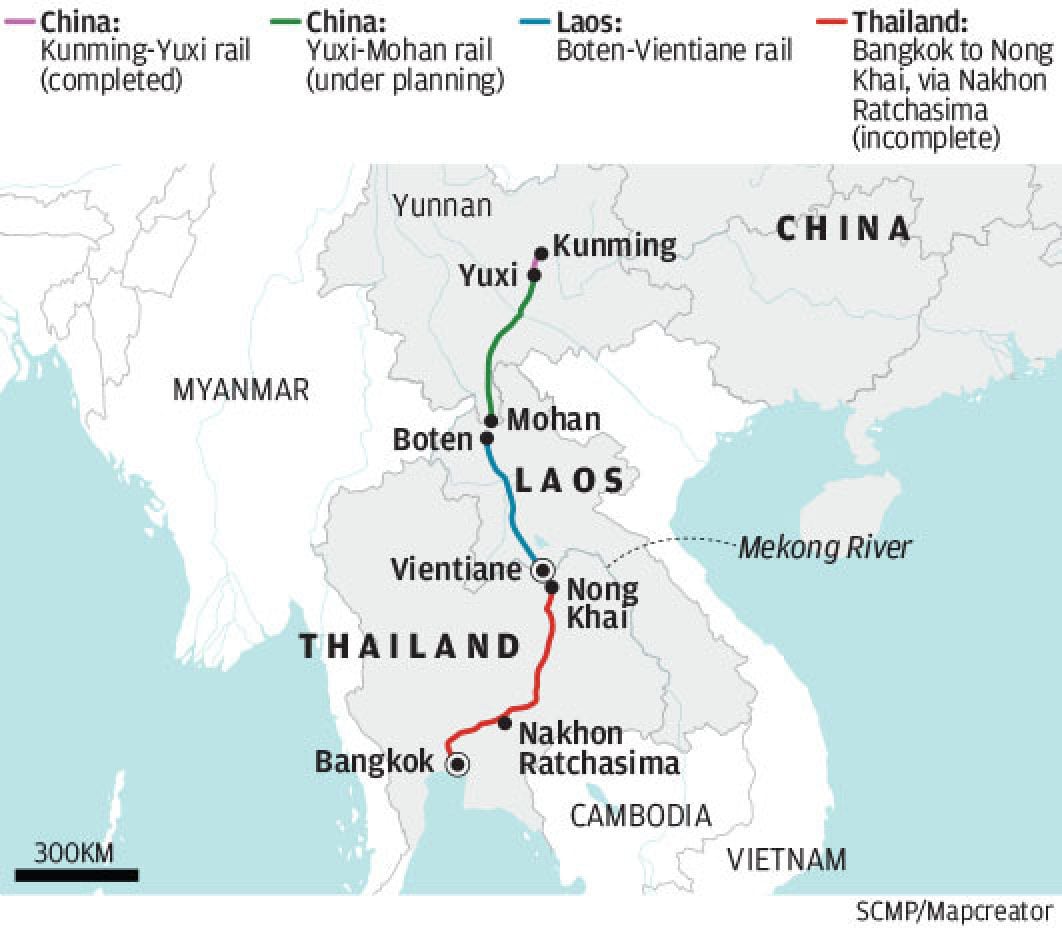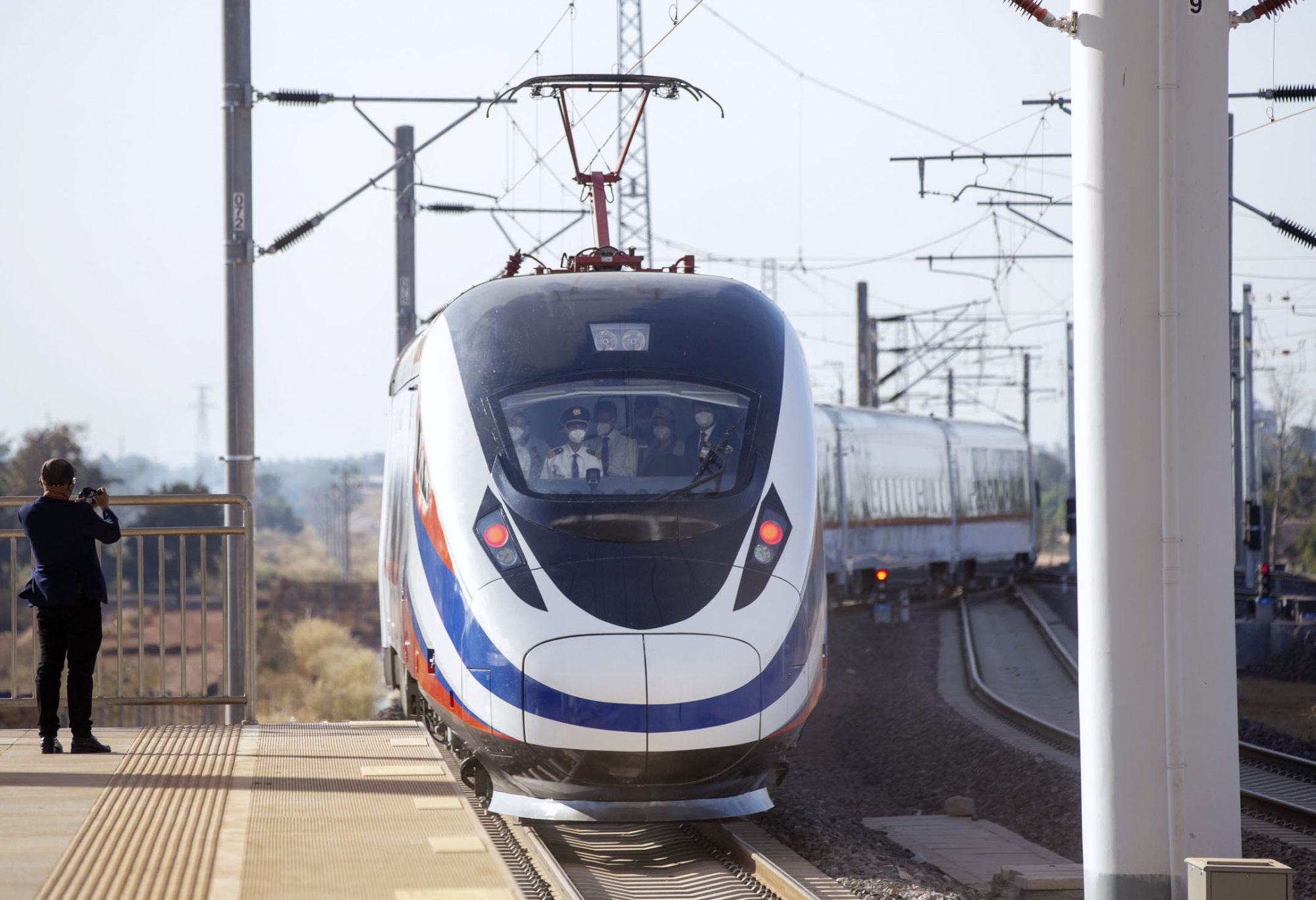
Thai traders anxious over ‘influx’ of Chinese produce as progress to extend belt and road railway slows
- With the Laos part of the Kunming to Singapore rail project up and running, Thai traders struggle to compete as Chinese imports arrive faster and fresher than ever
- Thailand’s section of the railway remains mired in delays, raising concerns that the country could lose its hub status to its neighbour
While broccoli, cabbages and other winter produce from China have been staples at his shop for the past decade because of Thailand’s year-round tropical climate, in the past month a surge of imports has pushed down the prices of Thai vegetables.
“Chinese vegetables have automatically forced Thai growers to reduce their prices, otherwise they cannot compete,” he said.
Prayat expects the prices of Thai produce to pick up in the summer season, when local greens have traditionally dominated the stalls. However, he fears that in the long run cheaper Chinese produce could overwhelm the Thai market, leaving Thai growers vulnerable.

Trade headaches
Prayat’s anxiety follows the December opening of the high-speed railway, which has made it easier and faster to import Chinese vegetables in greater amounts.
On January 3, a month after the railway launched, Xinhua reported that it had transported more than 170,000 tonnes of cargo. Much of that cargo was made up of vegetables, fruit and mechanical and electrical products being taken out of China, and natural rubber going in the other direction.
The development is a concern not only for traders, but ordinary Thais who were quick to voice their concerns on a YouTube video story about the rail.
The rail took many years to complete, and Thailand didn’t foresee this influx?
One commenter warned that, while the rail had given consumers more options, Thai farmers risked losing business to Chinese competitors. Another said, “The rail took many years to complete, and Thailand didn’t foresee this influx?”
This would be a boon for Thai traders but also “make it difficult for Thai vegetable growers to compete as the rail has shortened the travelling time between Kunming [in China’s Yunnan province] and Vientiane to 10 hours,” Aat said.
He suggested that Thai farmers should be given government support to keep them competitive.

Such developments come amid complaints by fruit exporters in Thailand over recent restrictions at the border that have been implemented as part of China’s zero-Covid policy.
The heavy testing of cargo at the border meant Thai produce such as durians or langans often faced a long wait, threatening their condition and price, said Thai fruit exporter Sanchai Puranachaikiri.
But in the other direction, with the high-speed railway having cut the journey time, vegetables from China are now reaching Talaad Thai faster – and fresher – than ever. Thai authorities recently reported more than 660 tonnes of Chinese vegetables had reached Thailand in just one week.
With US$1.5 billion debt load, can Laos reap profits from China rail link?
Last week, Thai Minister of Commerce Jurin Laksanawisit visited the customs checkpoint at the Thai-Laos Friendship Bridge in Nong Khai province, just across the Mekong river from the Laotian capital of Vientiane where the high-speed railway terminates. China currently allows goods related to ore, rubber and cassava on the train but Jurin said he would also negotiate for the permission to transport Thai fruits during the harvesting season between March and May.
Thailand is one of China’s biggest sources of fruit and the high-speed railway provides greater opportunities to its exporters. Even so, observers warn, the influx of Chinese produce could lead to Thailand losing its trade surplus with China in the future.

Delayed opportunities
It is hoped that the project will boost trade and tourism in both directions.
However, Thailand’s end of the project risks being compromised by delays to the portion of the rail that connects its Nong Khai province to Bangkok. Aat said that section could take at least another eight years to complete.
The delay, he said, was mainly because the Thai portion of the rail lacked financial backing from China – unlike the 414km, USS$5.9 billion Laos section, which was completed in five years thanks to 70 per cent of the budget being covered by Beijing and loans.
So far China had provided only technical and design assistance to Thailand, which was hoping to rely on domestic capital to finish the project, Aat said.
“It depends on the state of the Thai economy in coming years,” he added.
Thailand’s section is made up of the 253km Bangkok-Nakhon Ratchasima section, the 356km Nakhon Ratchasima-Nong Khai section and a 16km track connecting Nong Khai to Vientiane. The Thai government expects the first phase to be operational in 2026.
[This is] a game changer for the Laos economy
The delay to the Thai section will give a competitive boost to Laos. “Laos will be a hub of agricultural trade in mainland Asean and Thai businesses will find themselves almost unable to compete because many businesses in Laos are owned by Chinese,” Aat said.
Nick J. Freeman, associate fellow in the Myanmar Studies Programme at the ISEAS – Yusof Ishak Institute, wrote in a paper published in November that the project was a “game changer for the Laos economy”.
“A dedicated ‘dry port’ is being developed at Thanaleng, close to Vientiane, for freight traffic. Its facilities will include a bonded warehouse, a transshipment station, a container port and other logistical services,” Freeman wrote.
“Tourists from China visiting Laos are expected to use the line, while Lao companies will be presented with an opportunity to transport their goods more easily, speedily and cheaply to China’s huge market.”
Varavudh Meesaiyati, president of the Thai Business Association of the Lao People’s Democratic Republic, said Thailand was relying on neighbouring Laos due to the high-speed railway.
“Thailand sees itself as a [logistics] hub. I think Laos is actually a hub because now Thai goods have to be transported via Laos’ dry port at Vientiane Logistics Park.”
As China-backed belt and road railway opens, high-speed change heads to Laos
Varavudh said the construction of a bridge to accommodate rail freight between Nong Khai and Vientiane should be made a priority.
Nong Khai businessman Warakorn Jiansermsin said real estate in the northeastern province was booming because of the high-speed railway, as companies wanted to rent or purchase land to build warehouses. He said that many Thai businesses were looking to purchase land in Laos for the same purpose.
Laos’ development could be further boosted by a proposed 555km railway linking the country to Vung Ang Port in Vietnam, Aat said. This would provide the landlocked Laos with a route to the Pacific sea trade, eventually enabling it to bypass the Laem Chabang port in Thailand’s Eastern Economic Corridor, which is about 700km from Vientiane.
Said Aat: “Thailand should grasp more opportunities. We could have done a lot in the past five years when the high-speed train was being constructed, but we didn’t act on it at all.”

